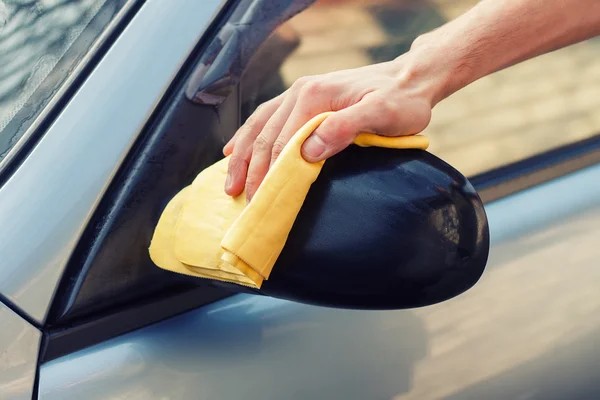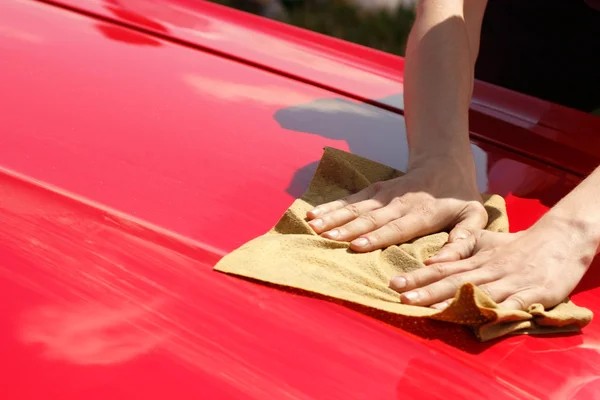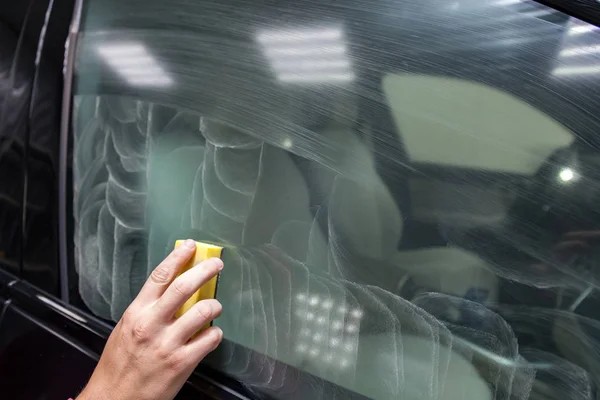In recent years, the buzz around Car Waterless Cleaner products has grown significantly, especially among environmentally conscious car owners and those living in urban areas. These cleaners promise a convenient and eco-friendly way to wash your car without using any water. But are they as good as they sound?
This article dives deep into the world of car waterless cleaners, exploring their potential downsides and what they could mean for your car’s appearance and long-term health.
 Hand with rag polish the side mirror of car – alt text: Close-up of hand polishing car side mirror with microfiber cloth using waterless car cleaner spray
Hand with rag polish the side mirror of car – alt text: Close-up of hand polishing car side mirror with microfiber cloth using waterless car cleaner spray
Understanding Car Waterless Cleaner
A car waterless cleaner is, simply put, a car cleaning solution that doesn’t require water. These products typically come in spray bottles. You apply the spray onto your car’s dirty surface and then wipe it off with a clean microfiber towel. The goal is to offer a quick and easy cleaning method that conserves water, perfect for those with busy lifestyles.
To understand if this method is right for you, it’s important to know how these cleaners actually work. Generally, these sprays contain a blend of lubricants and cleaning agents. These components work together to surround and lift dirt particles from the car’s surface. This encapsulation allows you to safely wipe away the grime without scratching the paint.
However, the effectiveness of a car waterless cleaner heavily depends on the product’s quality and the correct application technique.
The Rising Popularity of Waterless Car Cleaners
Several factors contribute to the increasing popularity of car waterless cleaners:
Firstly, convenience is a major draw. You can wash your car virtually anywhere – in your garage, in a parking lot, or on the street. There’s no need for hoses, buckets, or soap. This ease of use is particularly appealing to city dwellers who may not have easy access to traditional car washing setups.
Secondly, they are marketed as eco-friendly. With growing environmental awareness, many consumers are looking for ways to reduce their water footprint. Car waterless cleaners are seen as a step towards sustainable car care by minimizing water usage.
Their portability is another advantage. Easy to store and carry, they are great for quick clean-ups while traveling.
Finally, they can be perceived as cost-effective. While the initial cost of a bottle might seem higher than car soap, a single bottle can often clean your car multiple times, potentially offering better value than frequent trips to a car wash.
 Professional Car Washer Wipes Dries Window Car Washing Service Concept – alt text: Professional car detailer wiping and drying car window with microfiber cloth after waterless wash application
Professional Car Washer Wipes Dries Window Car Washing Service Concept – alt text: Professional car detailer wiping and drying car window with microfiber cloth after waterless wash application
Potential Downsides of Car Waterless Cleaner
Despite their benefits, car waterless cleaners have potential drawbacks. One of the biggest concerns is the risk of scratches and paint damage.
When you wipe dirt off a dry car surface, even with lubricants, there’s always a chance of dragging abrasive particles across the paint. This can lead to fine scratches and swirl marks, especially on darker colored vehicles.
Another limitation is their cleaning power against heavy dirt. While effective for light dust and fresh fingerprints, waterless cleaners might struggle with tougher substances like dried bird droppings, mud, or heavy road grime. For these, a traditional car wash with water and soap is often more effective at safely removing debris.
Furthermore, car waterless cleaners may not effectively remove certain contaminants like water spots or ingrained stains that can damage your car’s paint over time. While your car may look clean immediately after using a waterless cleaner, long-term, these issues can detract from its appearance and value.
Safe Usage of Car Waterless Cleaner
If you decide to use a car waterless cleaner, you can minimize risks by following these safety tips:
First, choose a high-quality product specifically designed for your car’s finish. Cheaper products may lack sufficient lubrication, increasing the risk of scratches.
Use multiple microfiber towels. Employ the two-bucket method in spirit, even without water buckets. Use one towel to wipe away dirt and switch to a clean towel for buffing. Fold your towel into quarters and use a fresh side for each section of the car to avoid redepositing dirt.
Assess the level of dirt on your car. If your car is heavily soiled, especially with mud or caked-on dirt, a traditional wash is recommended before using a waterless cleaner for touch-ups. Waterless cleaners are best suited for light cleaning and maintenance between thorough washes.
Alternatives to Car Waterless Cleaners
If you are eco-conscious but concerned about the risks of waterless cleaners, several alternatives minimize water usage while ensuring a safe and effective clean.
Rinse-less car washes are a great option. These products require only a minimal amount of water mixed in a bucket. You apply the solution with a sponge or microfiber cloth and then dry the car – no rinsing needed. They offer a good balance between water conservation and effective cleaning.
Low-pressure hoses with water-saving nozzles can also significantly reduce water consumption compared to open-hose washing, making traditional washing more water-efficient.
Professional car wash services, like Love My Car Car Wash, often utilize water-efficient systems and high-quality products, providing an environmentally conscious yet thorough cleaning solution.
 Love My Car CarWash logo – alt text: Love My Car Car Wash logo, professional car detailing service provider
Love My Car CarWash logo – alt text: Love My Car Car Wash logo, professional car detailing service provider
Effective Alternatives to Waterless Car Wash
Beyond rinse-less washes, here are other effective alternatives to maintain your car’s appearance without relying solely on waterless cleaners:
- Car Detailing Sprays: Excellent for quick touch-ups and removing light dust or fingerprints between washes.
- Clay Bars: Effective for removing embedded contaminants that waterless cleaners cannot handle.
- Quick Detailers: Boost shine and offer light cleaning, ideal for maintaining a freshly washed look.
- Waterless Wash Waxes: Combine cleaning with a layer of wax protection.
- Foam Cannons (with Water-Saving Nozzles): For a more thorough pre-wash to loosen dirt before contact washing, using minimal water.
- Steam Cleaners: Use minimal water and are effective for both interior and exterior cleaning.
These alternatives can complement traditional cleaning methods and address some limitations of car waterless cleaners, ensuring your vehicle stays in top condition.
 Car wash – alt text: Exterior car wash bay with water spraying and brushes for thorough vehicle cleaning
Car wash – alt text: Exterior car wash bay with water spraying and brushes for thorough vehicle cleaning
Long-Term Effects of Car Waterless Cleaner on Car Surfaces
Consistent use of car waterless cleaners can, over time, affect your car’s paint quality. While they offer a temporary shine, they don’t typically provide the same level of long-term protection as traditional wax or ceramic coatings.
Without regular waxing or sealant application, painted surfaces can become dull and more susceptible to environmental damage from UV rays and pollutants. Traditional car washes often incorporate protective treatments that help maintain shine and protect the paint.
Furthermore, the potentially inconsistent cleaning action of waterless cleaners can lead to uneven wear on different areas of the car’s paint, affecting its overall aesthetic appeal and potentially reducing resale value.
 The man’s hand applies a degreasing cleaner with a yellow spon – alt text: Hand applying degreasing cleaner with yellow sponge for car detailing and surface preparation
The man’s hand applies a degreasing cleaner with a yellow spon – alt text: Hand applying degreasing cleaner with yellow sponge for car detailing and surface preparation
Environmental Considerations of Car Waterless Cleaners
While car waterless cleaners are promoted as water-saving, their overall environmental impact is not entirely straightforward.
The production and disposal of plastic spray bottles and microfiber towels contribute to environmental waste. Many plastic bottles are not effectively recycled, and microfiber, being plastic-based, also poses disposal challenges.
Additionally, some car waterless cleaner formulations contain chemicals that may not be biodegradable. When these chemicals are wiped off your car, they can end up in the environment, potentially impacting local ecosystems.
For genuinely eco-conscious consumers, it’s crucial to research the ingredients of any waterless cleaner to ensure they align with sustainable practices, looking for biodegradable and environmentally friendly formulations.
Proper Cleaning Techniques: Key to Success
Regardless of your chosen cleaning method, proper technique is paramount.
Always start cleaning from the least dirty areas of your car and move towards the dirtier sections. This minimizes the transfer of heavy grime to cleaner areas. Change towels frequently as they become soiled.
When using a car waterless cleaner, spray the product and gently wipe in straight lines, rather than circular motions. This technique helps to minimize the appearance of swirl marks, which are more noticeable on darker paints.
Proper drying is equally important. Use a clean, dry microfiber cloth to immediately dry the surfaces after cleaning to prevent water spots, even with waterless cleaners. Air drying can lead to mineral deposits and water spots that are harder to remove.
Expert Opinions on Car Waterless Cleaners
Many professional automotive detailers offer a balanced perspective on car waterless cleaners. They acknowledge the convenience but emphasize understanding their limitations.
Detailers often recommend using waterless cleaners for quick touch-ups between more thorough traditional washes. This hybrid approach allows for maintaining a clean car without sacrificing the deep cleaning provided by water and soap for heavier dirt removal.
For car enthusiasts and those who are particularly invested in their vehicle’s appearance, the consensus is that a combination of waterless products for light maintenance and regular, thorough washes is the best approach for optimal results.
Consumer Experiences with Car Waterless Cleaners
User reviews of car waterless cleaners are varied. Many appreciate the convenience, especially for apartment living or areas with water restrictions.
However, some users find the cleaning performance lacking, particularly with stubborn dirt.
Owners of lighter-colored cars often report better results, as minor scratches and imperfections are less visible. Conversely, owners of darker vehicles are more likely to notice swirl marks and might prefer traditional washing for better control and deeper cleaning.
Ultimately, individual experiences vary widely based on the specific product used, the car’s condition, and the user’s cleaning diligence.
 Love My Car CarWash Employee cleaning a car – alt text: Car wash employee detailing vehicle interior for professional cleaning service
Love My Car CarWash Employee cleaning a car – alt text: Car wash employee detailing vehicle interior for professional cleaning service
Conclusion: Making an Informed Choice About Car Waterless Cleaner
Car waterless cleaners provide a convenient, water-conserving option for maintaining your car’s cleanliness, especially for eco-conscious individuals and urban residents.
However, they are not without their challenges. Potential risks like scratches and limitations in cleaning heavy dirt mean they are not a perfect solution for every situation.
If you choose to use car waterless cleaners, following best practices, such as using high-quality products and proper techniques, is crucial to minimize damage and maximize cleaning effectiveness.
Consider a balanced approach: use waterless cleaners for quick maintenance and supplement with traditional washing methods for deeper cleans when needed.
By understanding both the advantages and disadvantages of car waterless cleaners, you can make an informed decision that keeps your vehicle looking its best while aligning with your car care preferences and environmental values. For further insights, consider consulting with professional detailers or engaging with car care communities to learn from shared experiences and expert advice.
